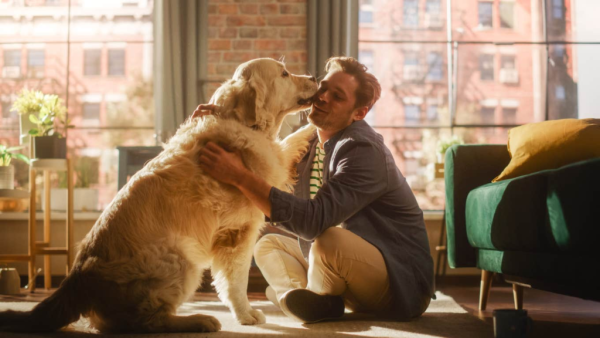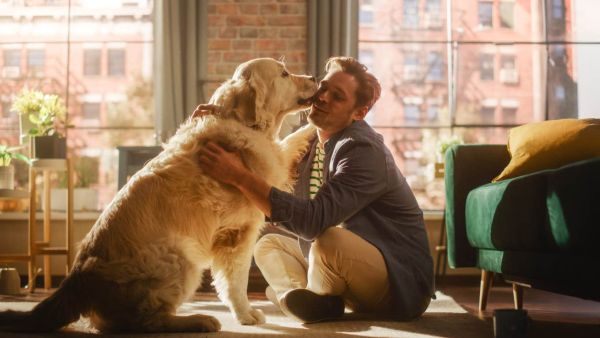

We hear it all the time and have probably said it ourselves: “My dog just KNOWS when I’m sad” or “My cat just KNOWS when I need a cuddle.” But is it true?
Can our pets actually feel empathy? The jury is still out on the exact definition of what our pets feel, but it turns out they really are adept at sensing our emotional state. In fact, science has found that they’re far better at reading us than we humans are at reading them.
I used to know a guy whose little dog Jerry was so talented at reading him that he actually knew when his owner was sick long before he did. He once spent two entire days obsessively pawing and whining at his owner’s stomach, which turned out to be a warning about a terrible bout of food poisoning. Years later, when he did it again, it turned out to be stomach cancer.
There’s little doubt in most pet owners’ minds that their furry friends are in tune with far more than just when it’s time for dinner or scritches. One study showed that 80% of dog owners believe their pup has helped them through a tough time. And accordingly, animals are actually experts at reading us.
: 5 Quiet Ways Having A Pet Heals Your Mind, Body, & Soul, According To An Animal Behavior Scientist
Eye-tracking studies, reported on by The Guardianhave shown that dogs have a protocol for sizing each other up. They first take notice of what their ears are doing, then their mouths, and then their eyes. But for humans, this process is in a completely different order and focuses far more heavily on one side of the face.
When dogs see a human, they focus first on the forehead and eyebrows, then the cheeks, and finally the eyes, to discern what the facial muscles are saying about how we feel. However, unlike dogs, our faces are asymmetrical, and our left sides tend to be more expressive. Dogs have sussed this out and focus their reconnaissance missions specifically on the left sides of our faces.
Doctor Unface | Pexels | Canva Pro
Cats also have a system for evaluating our facial expressions, as well as the tones of our voices. And as any cat owner will tell you, they also have different meows designed to elicit different responses from us. Much like dogs, this process is different when they are communicating with other cats than with humans.
But, there has been substantial disagreement among researchers as to what this all actually means. Are they just evaluating cues and noting differences in behavior, or are they actually able to connect with us emotionally?
: 5 Sweet Ways Your Cat Tells You They Love You
The debate has centered on whether our pets are actually feeling for us, or whether they’re just reacting to something like emotional contagion. For example, when a baby cries and suddenly all the other babies in the room start crying for no reason, that’s emotional contagion.
To test this, one study used emotional contagion tests typically given to toddlers to see how dogs would react. One involved having dogs witness their owners cry, and then having a stranger added to the mix who cries instead. When the owners cried, the dogs, of course, approached them gently, placing a paw on them or whimpering.
If they were only responding to emotional contagion, that is, responding to a change in dynamics in the room that made them uncomfortable, it would be expected that they’d have the same response when the stranger cried and go to their owner for comfort and reassurance.
But instead, most dogs went to comfort the stranger, leading researchers to conclude that more than emotional contagion was at play. Perhaps dogs actually did understand that the stranger was upset, and they wanted to comfort them.
When a similar study was done on cats, they did things a bit differently. Noticing that a human was in distress, cats would show stress responses like grooming a paw. Whether they were stressed on behalf of the human or stressed because they need the human as a resource is unknown, but regardless, it showed the level to which they understand our human experiences.
Contrary to our smart little pets, studies have shown that we humans tend to misread our dogs’ and cats’ emotional responses all the time, mainly because we anthropomorphize them and judge their responses based on the situation.
 Jess Wealleans | Getty Images Pro | Canva Pro
Jess Wealleans | Getty Images Pro | Canva Pro
For instance, an Arizona State University study found that pet owners could not reliably determine if a dog or cat was sad or happy based on video footage of their face. When shown video footage of the full situation, they were somewhat more accurate, but based their judgments on the situation. A positive situation like being given a toy must mean they’re happy, right?
But that’s not how dogs and cats actually work. They could just as easily be agitated by the new toy as happy about it. The study dug deeper by showing the same images of dogs and cats against different backgrounds. Happy backgrounds made respondents say the animal was happy, while sad or scary backgrounds made respondents say the animal was sad or scared.
And perhaps most notably, when asked, respondents insisted they didn’t use context to make their judgments, but instead evaluated their actions and demeanor, showing just how much we overestimate our ability to read our pets.
Explaining this to The Guardian, Dr. Karen Hiestand, a lecturer in veterinary and animal ethics at the Royal Veterinary College in the U.K., used the idea of a dog or cat feeling “guilty” for something it did as an example of this. “When you get home and they’ve ripped up a cushion, what you’re seeing isn’t guilt — it’s fear. They are picking up that you are angry or upset.”
All of which just goes to show how much our animals really do care about us. Not only do they feel genuine affection and concern, but they’re far better at knowing what we need than the other way around. Which makes their companionship all the more meaningful.
: The Sweet Way A Dog Only Greets The Person They Love The Most
John Sundholm is a writer, editor, and video personality with 20 years of experience in media and entertainment. He covers culture, mental health, and human interest topics.